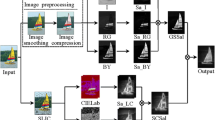Abstract
In this paper, we propose a new multiscale saliency detection algorithm based on image patches. To measure saliency of pixels in a given image, we segment the image into patches by a fixed scale and then use principal component analysis to reduce the dimensions which are noises with respect to the saliency calculation. The dissimilarities between a patch and other patches, which indicate the patch’s saliency, are computed based on the dissimilarity of colors and the spatial distance. Finally, we implement our algorithm through multiple scales that further decrease the saliency of background. Our method is compared with other saliency detection approaches on two public image datasets. Experimental results show that our method outperforms the state-of-the-art methods on predicting human fixations and salient object segmentation.








Similar content being viewed by others
References
Santella A, Agrawala M, Decarlo D, Salesin D, Cohen M (2006) Gaze-based interaction for semi-automatic photo cropping. In: ACM human factors in computing systems (CHI). ACM, Montreal, pp 771–780
Chen L, Xie X, Fan X, Ma W, Shang H, Zhou H (2002) H A visual attention mode for adapting images on small displays. Technical report, Microsoft Research, Redmond, WA
Itti L (2000) Models of bottom-up and top-down visual attention. PhD thesis, California Institute of Technology, Pasadena
Navalpakkam V, Itti L (2006) An integrated model of top-down and bottom-up attention for optimizing detection speed. In: IEEE conference on computer vision and pattern recognition (CVPR), pp 2049–2056
Rutishauser U, Walther D, Koch C, Perona P (2004) Is bottom-up attention useful for object recognition? In: IEEE conference on computer vision and pattern recognition (CVPR), pp 37–44
Jong Seo H, Milanfar P (2009) Nonparametric bottom-up saliency detection by self-resemblance. In: IEEE conference on computer vision and pattern recognition (CVPR), pp 45–52
Baldi P, Itti L (2010) Of bits and wows: a Bayesian theory of surprise with applications to attention. Neural Netw 23(5):649–666
Torralba A, Oliva A, Castelhano M, Henderson J (2006) Contextual guidance of eye movements and attention in real-world scenes: the role of global features on object search. Psychol Rev 113(4):766–786
Itti L, Koch C, Niebur E (1998) A model of saliency-based visual attention for rapid scene analysis. IEEE Trans Pattern Anal Mach Intell 20(11):1254–1259
Hou X, Zhang L (2008) Saliency detection: a spectral residual approach. In: IEEE conference on computer vision and pattern recognition (CVPR), pp 1–8
Guo C, Ma Q, Zhang L (2008) Spatio-temporal saliency detection using phase spectrum of quaternion Fourier transform. In: IEEE conference on computer vision and pattern recognition (CVPR), pp 1–8
Ma Y-F, Zhang H (2003) Contrast-based image attention analysis by using fuzzy growing. In: ACM multimedia, pp 374–381
Itti L, Baldi P (2005) Bayesian surprise attracts human attention. In: NIPS, Cambridge
Liu T, Sun J, Zheng N, Tang X, Shum H-Y (2007) Learning to detect a salient object. In: CVPR
Goferman S, Zelnik-Manor L, Tal A (2010) Context-aware saliency detection. In: CVPR, pp 2376–2383
Jiang H et al (2011) Automatic salient object segmentation based on context and shape prior. In: BMVC
Achanta R, Hemami S, Estrada F, Süsstrunk S (2009) Frequency-tuned salient region detection. IEEE conference on computer vision and pattern recognition (CVPR), pp 1597–1604
Cheng M et al (2011) Global contrast based salient region detection. In: IEEE conference on computer vision and pattern recognition (CVPR), pp 409–416
Duan L, Wu C, Miao J, Qing L, Fu Y (2011) Visual saliency detection by spatially weighted dissimilarity. In: IEEE conference on computer vision and pattern recognition (CVPR), pp 21–23
Tatler BW (2007) The central fixation bias in scene viewing: selecting an optimal viewing position independently of motor biases and image feature distributions. J Vis 7(14):4.1–4.17
Bruce N, Tsotsos J (2006) Saliency based on information maximization. In: Advances in neural information processing systems, pp 155–162
Hou X, Harel J, Koch C (2012) Image signature: highlighting sparse salient regions. IEEE Trans Pattern Anal Mach Intell 34(1):194–201
Yang J, Zhang D, Frangi AF, Yang JY (2004) Two-dimensional PCA: a new approach to appearance-based face representation and recognition. IEEE Trans Pattern Anal Mach Intell 26(1):131–137
Kadir T, Brady M (2001) Saliency, scale and image description. Int J Comput Vis 45(2):83–105
Hyvärinen A, Hurri J, Hoyer PO (2009) Natural image statistics: a probabilistic approach to early computational vision. Springer, London
Zhang L, Tong M, Marks T, Shan H, Cottrell G (2008) SUN: a Bayesian framework for saliency using natural statistics. J Vis 8(7):1–20
Gao D, Mahadevan V, Vasconcelos N (2008) On the plausibility of the discriminant center-surround hypothesis for visual saliency. J Vis 8(7):1–18
Gao D, Vasconcelos N (2004) Discriminant saliency for visual recognition from cluttered scenes. In: Advances in neural information processing systems, pp 481–488
Harel J, Koch C, Perona P (2007) Graph-based visual saliency. In: Advances in neural information processing systems, pp 545–555
Achanta R, Estrada FJ, Wils P, Süsstrunk S (2008) Salient region detection and segmentation. In: ICVS, pp 66–75
Acknowledgments
This research is partially sponsored by Natural Science Foundation of China (No. 90820306 and No. KT06015), Natural Science Research Project of Jiang Su Provincial Colleges and Universities (No. 11KJD520003). The authors would like to thank the technical assistance from the PhD student Dongyan Guo.
Author information
Authors and Affiliations
Corresponding author
Rights and permissions
About this article
Cite this article
Zhou, J., Jin, Z. A New Framework for Multiscale Saliency Detection Based on Image Patches. Neural Process Lett 38, 361–374 (2013). https://doi.org/10.1007/s11063-012-9276-3
Published:
Issue Date:
DOI: https://doi.org/10.1007/s11063-012-9276-3




